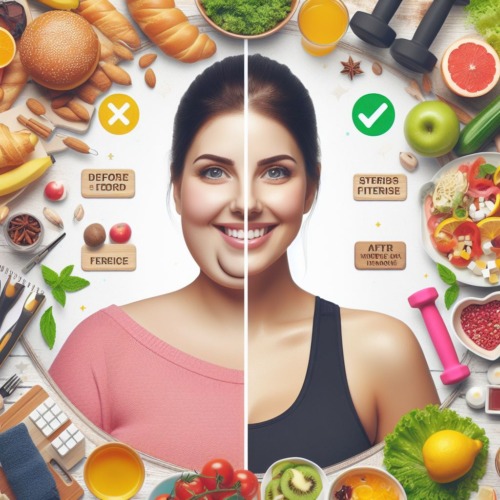How to Reduce Face Fat: A Comprehensive Guide
Excess face fat can be a source of frustration for many people, affecting both appearance and self-confidence. While there’s no magic solution to target fat loss specifically in the face, a combination of proper diet, exercise, lifestyle changes, and targeted facial exercises can help slim down the face and enhance overall facial features.
This guide will explore effective strategies to reduce face fat, providing a holistic approach to achieving a more defined and contoured face.
Understanding Face Fat and Its Causes
 Before diving into methods to reduce face fat, it's important to understand what contributes to facial fat accumulation. Multiple factors can influence the distribution of fat in the face, including genetics, overall body fat percentage, diet, lifestyle, and aging.
Before diving into methods to reduce face fat, it's important to understand what contributes to facial fat accumulation. Multiple factors can influence the distribution of fat in the face, including genetics, overall body fat percentage, diet, lifestyle, and aging.
- Genetics
Genetics play a significant role in determining where your body stores fat, and for some people, the face is a primary area. While you can’t change your genetic predisposition, you can manage other contributing factors to reduce overall body fat, which in turn, can help slim your face.
- Overall Body Fat Percentage
Your overall body fat percentage is directly linked to facial fat. As you lose body fat through a balanced diet and regular exercise, you'll likely notice a reduction in face fat as well. Focusing on overall weight loss rather than spot reduction is crucial for achieving a leaner face.
- Diet and Nutrition
What you eat has a direct impact on fat accumulation. Consuming a diet high in processed foods, sugars, and unhealthy fats can lead to weight gain, including in the face. Conversely, a diet rich in whole foods, lean proteins, healthy fats, and vegetables can promote weight loss and reduce facial fat.
- Lifestyle Factors
Lifestyle habits such as sleep, hydration, and stress management also play a role in fat distribution. Poor sleep, dehydration, and high stress levels can contribute to weight gain and bloating, which can make your face appear puffier.
Dietary Changes for Reducing Face Fat
 A balanced and nutritious diet is fundamental for reducing overall body fat, including facial fat. Here are key dietary changes to consider:
A balanced and nutritious diet is fundamental for reducing overall body fat, including facial fat. Here are key dietary changes to consider:
- Eat a Balanced Diet
Focus on a diet that includes a variety of nutrient-dense foods:
- Lean Proteins: Chicken, turkey, fish, beans, and legumes help build muscle and keep you full longer.
- Healthy Fats: Avocados, nuts, seeds, and olive oil provide essential fatty acids that support overall health.
- Whole Grains: Brown rice, quinoa, oats, and whole-wheat products are rich in fiber and help regulate blood sugar levels.
- Fruits and Vegetables: These are low in calories and high in vitamins, minerals, and antioxidants that support weight loss and overall health.
- Reduce Salt and Sugar Intake
Excessive salt and sugar can lead to water retention and bloating, making your face appear puffier:
- Limit Processed Foods: These often contain high levels of salt and sugar.
- Avoid Sugary Drinks: Soft drinks, energy drinks, and even fruit juices can contribute to weight gain.
- Opt for Natural Sweeteners: Use honey or maple syrup in moderation instead of refined sugar.
- Stay Hydrated
Drinking enough water is crucial for overall health and can help reduce face fat by preventing bloating and flushing out toxins:
- Aim for at least 8 glasses of water a day.
- Include water-rich foods: Cucumbers, watermelon, and lettuce can help keep you hydrated.
Exercise and Physical Activity
 Regular physical activity is essential for overall fat loss, including facial fat. Incorporating both cardiovascular exercises and strength training can yield the best results.
Regular physical activity is essential for overall fat loss, including facial fat. Incorporating both cardiovascular exercises and strength training can yield the best results.
- Cardiovascular Exercise
Cardio workouts are effective for burning calories and reducing body fat:
- Running or Jogging: These activities burn a significant number of calories and improve cardiovascular health.
- Cycling: A low-impact exercise that’s great for burning fat and building endurance.
- Swimming: A full-body workout that burns calories and builds muscle.
- Strength Training
Building muscle mass through strength training can increase your metabolism, helping you burn more calories even at rest:
- Weight Lifting: Incorporate exercises that target all major muscle groups.
- Bodyweight Exercises: Push-ups, squats, and lunges are effective for building strength without equipment.
- Resistance Bands: These are versatile tools for strength training and can be used anywhere.
- Facial Exercises
Targeted facial exercises can help tone facial muscles and reduce the appearance of face fat:
- Cheek Lifts: Smile as wide as you can while pressing your lips together, then lift your cheeks upwards. Hold for a few seconds and repeat.
- Jaw Release: Simulate chewing while keeping your lips closed. Breathe in and out deeply while humming. This helps tone the jawline.
- Fish Face: Suck in your cheeks and lips to make a fish face, then hold for a few seconds and repeat.
- Chin Lifts: Tilt your head towards the ceiling, purse your lips as if you are kissing the ceiling, hold for a few seconds, and repeat.
Lifestyle Changes and Habits
Beyond diet and exercise, certain lifestyle changes can support your efforts to reduce face fat and enhance overall well-being.
- Get Enough Sleep
Adequate sleep is essential for weight management and reducing facial puffiness:
- Aim for 7-9 hours of quality sleep each night.
- Maintain a consistent sleep schedule: Go to bed and wake up at the same time every day, even on weekends.
- Create a restful environment: Keep your bedroom cool, dark, and quiet.
- Manage Stress
Chronic stress can lead to weight gain and bloating. Incorporate stress management techniques into your daily routine:
- Practice Mindfulness: Meditation, yoga, and deep breathing exercises can help reduce stress levels.
- Stay Active: Physical activity is a natural stress reliever and can help regulate your mood.
- Engage in Hobbies: Activities you enjoy can provide a mental break and reduce stress.
- Avoid Alcohol and Smoking
Both alcohol and smoking can contribute to weight gain and bloating:
- Limit Alcohol Consumption: Alcoholic beverages are high in empty calories and can lead to dehydration.
- Quit Smoking: Smoking can affect your metabolism and overall health, making weight management more challenging.
- Regular Check-Ins and Adjustments
Regularly monitor your progress and make adjustments as needed to your diet, exercise, and lifestyle habits:
- Track Your Food Intake: Use a journal or app to log what you eat and identify areas for improvement.
- Measure Your Progress: Take photos and measurements to see changes over time.
- Adjust Your Plan: If you’re not seeing results, consider consulting a nutritionist or fitness professional for personalized advice.
Conclusion
Reducing face fat requires a holistic approach that combines a balanced diet, regular exercise, and healthy lifestyle changes. By understanding the factors that contribute to facial fat and implementing the strategies outlined in this guide, you can achieve a slimmer, more defined face. Remember that consistency is key, and making gradual, sustainable changes will yield the best long-term results. Embrace the journey towards a healthier, more confident you.
Reference
Diet and Exercise Tips
National Institute on Alcohol Abuse and Alcoholism - Effects of Alcohol
Centers for Disease Control and Prevention - Benefits of Quitting Smoking
































































